INSTITUT SUPERIEUR D'ANTHROPOLOGIE
INSTITUT OF ANTHROPOLOGY
COURS ONLINE – COURS A DISTANCE
INSCRIPTIONS : SEPTEMBRE 2024
REGISTER NOW
GRECE – 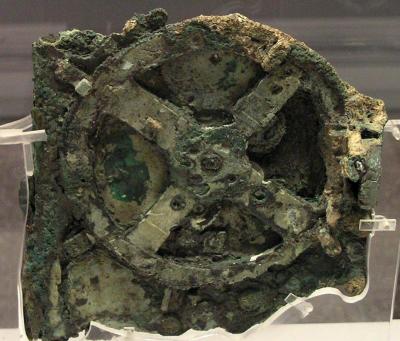 Antikythera - Astronomers from the University of Glasgow who specialize in studying tiny ripples in space-time have shed new light on the 2200-year-old Antikythera mechanism. Shoebox-sized device found in fragments and eroded was discovered in 1901 by divers exploring a sunken shipwreck near the Greek island of Antikythera. The Antikythera mechanism, also known as a “clockwork computer,” is a small bronze instrument that predates any machine of comparable complexity by over a millennium. The device sat in a museum for fifty years before historians began to take a serious look at it. Decades of subsequent research and analysis have established that the mechanism dates from the second century BCE and functioned as a kind of hand-operated mechanical computer. Exterior dials connected to the internal gears allowed users to predict eclipses and calculate the astronomical positions of planets on any given date with accuracy unparalleled by any other known contemporary device. Astronomers from the University of Glasgow have used statistical modeling techniques developed to analyze gravitational waves to establish the likely number of holes in one of the broken rings of the Antikythera mechanism – an ancient artifact that was showcased in the movie Indiana Jones and the Dial of Destiny. While the movie version enabled the intrepid archaeologist to travel through time, the Glasgow team’s results provide fresh evidence that one of the components of the Antikythera mechanism was most likely used to track the Greek lunar year. They also offer new insight into the remarkable craftsmanship of the ancient Greeks. In 2020, new X-ray images of one of the mechanism’s rings, known as the calendar ring, revealed fresh details of regularly spaced holes that sit beneath the ring. Since the ring was broken and incomplete, however, it wasn’t clear how just how many holes were there originally. Initial analysis by Antikythera researcher Chris Budiselic and colleagues suggested it was likely somewhere between 347 and 367. Now, in a new paper published today in the Horological Journal, the Glasgow researchers describe how they used two statistical analysis techniques to reveal new details about the calendar ring. They show that the ring is vastly more likely to have had 354 holes, corresponding to the lunar calendar, than 365 holes, which would have followed the Egyptian calendar. The analysis also shows that 354 holes is hundreds of times more probable than a 360-hole ring, which previous research had suggested as a possible count. Professor Graham Woan, of the University of Glasgow’s School of Physics & Astronomy, is one of the authors of the paper. He said: “Towards the end of last year, a colleague pointed to me to data acquired by YouTuber Chris Budiselic, who was looking to make a replica of the calendar ring and was investigating ways to determine just how many holes it contained. “It struck me as an interesting problem, and one that I thought I might be able to solve in a different way during the Christmas holidays, so I set about using some statistical techniques to answer the question.” Professor Woan used a technique called Bayesian analysis, which uses probability to quantify uncertainty based on incomplete data, to calculate the likely number of holes in the mechanism using the positions of the surviving holes and the placement of the ring’s surviving six fragments. His results showed strong evidence that the mechanism’s calendar ring contained either 354 or 355 holes. At the same time, one of Professor Woan’s colleagues at the University’s Institute for Gravitational Research, Dr Joseph Bayley, had also heard about the problem. He adapted techniques used by their research group to analyze the signals picked up by the LIGO gravitational wave detectors, which measure the tiny ripples in spacetime, caused by massive astronomical events like the collision of black holes, as they pass through the Earth, to scrutinize the calendar ring. The Markov Chain Monte Carlo and nested sampling methods Woan and Bayley used provided a comprehensive probabilistic set of results, again suggesting that the ring most likely contained 354 or 355 holes in a circle of radius 77.1mm, with an uncertainty of about 1/3 mm. It also reveals that the holes were precisely positioned with extraordinary accuracy, with an average radial variation of just 0.028mm between each hole. Bayley, a co-author of the paper, is a research associate at the School of Physics & Astronomy. He said: “Previous studies had suggested that the calendar ring was likely to have tracked the lunar calendar, but the dual techniques we’ve applied in this piece of work greatly increase the likelihood that this was the case. “It’s given me a new appreciation for the Antikythera mechanism and the work and care that Greek craftspeople put into making it – the precision of the holes’ positioning would have required highly accurate measurement techniques and an incredibly steady hand to punch them. Professor Woan added: “It’s a neat symmetry that we’ve adapted techniques we use to study the universe today to understand more about a mechanism that helped people keep track of the heavens nearly two millennia ago. “We hope that our findings about the Antikythera mechanism, although less supernaturally spectacular than those made by Indiana Jones, will help deepen our understanding of how this remarkable device was made and used by the Greeks.” The paper, titled ‘An Improved Calendar Ring Hole-Count for the Antikythera Mechanism: A Fresh Analysis’, is published in Horological Journal.
Antikythera - Astronomers from the University of Glasgow who specialize in studying tiny ripples in space-time have shed new light on the 2200-year-old Antikythera mechanism. Shoebox-sized device found in fragments and eroded was discovered in 1901 by divers exploring a sunken shipwreck near the Greek island of Antikythera. The Antikythera mechanism, also known as a “clockwork computer,” is a small bronze instrument that predates any machine of comparable complexity by over a millennium. The device sat in a museum for fifty years before historians began to take a serious look at it. Decades of subsequent research and analysis have established that the mechanism dates from the second century BCE and functioned as a kind of hand-operated mechanical computer. Exterior dials connected to the internal gears allowed users to predict eclipses and calculate the astronomical positions of planets on any given date with accuracy unparalleled by any other known contemporary device. Astronomers from the University of Glasgow have used statistical modeling techniques developed to analyze gravitational waves to establish the likely number of holes in one of the broken rings of the Antikythera mechanism – an ancient artifact that was showcased in the movie Indiana Jones and the Dial of Destiny. While the movie version enabled the intrepid archaeologist to travel through time, the Glasgow team’s results provide fresh evidence that one of the components of the Antikythera mechanism was most likely used to track the Greek lunar year. They also offer new insight into the remarkable craftsmanship of the ancient Greeks. In 2020, new X-ray images of one of the mechanism’s rings, known as the calendar ring, revealed fresh details of regularly spaced holes that sit beneath the ring. Since the ring was broken and incomplete, however, it wasn’t clear how just how many holes were there originally. Initial analysis by Antikythera researcher Chris Budiselic and colleagues suggested it was likely somewhere between 347 and 367. Now, in a new paper published today in the Horological Journal, the Glasgow researchers describe how they used two statistical analysis techniques to reveal new details about the calendar ring. They show that the ring is vastly more likely to have had 354 holes, corresponding to the lunar calendar, than 365 holes, which would have followed the Egyptian calendar. The analysis also shows that 354 holes is hundreds of times more probable than a 360-hole ring, which previous research had suggested as a possible count. Professor Graham Woan, of the University of Glasgow’s School of Physics & Astronomy, is one of the authors of the paper. He said: “Towards the end of last year, a colleague pointed to me to data acquired by YouTuber Chris Budiselic, who was looking to make a replica of the calendar ring and was investigating ways to determine just how many holes it contained. “It struck me as an interesting problem, and one that I thought I might be able to solve in a different way during the Christmas holidays, so I set about using some statistical techniques to answer the question.” Professor Woan used a technique called Bayesian analysis, which uses probability to quantify uncertainty based on incomplete data, to calculate the likely number of holes in the mechanism using the positions of the surviving holes and the placement of the ring’s surviving six fragments. His results showed strong evidence that the mechanism’s calendar ring contained either 354 or 355 holes. At the same time, one of Professor Woan’s colleagues at the University’s Institute for Gravitational Research, Dr Joseph Bayley, had also heard about the problem. He adapted techniques used by their research group to analyze the signals picked up by the LIGO gravitational wave detectors, which measure the tiny ripples in spacetime, caused by massive astronomical events like the collision of black holes, as they pass through the Earth, to scrutinize the calendar ring. The Markov Chain Monte Carlo and nested sampling methods Woan and Bayley used provided a comprehensive probabilistic set of results, again suggesting that the ring most likely contained 354 or 355 holes in a circle of radius 77.1mm, with an uncertainty of about 1/3 mm. It also reveals that the holes were precisely positioned with extraordinary accuracy, with an average radial variation of just 0.028mm between each hole. Bayley, a co-author of the paper, is a research associate at the School of Physics & Astronomy. He said: “Previous studies had suggested that the calendar ring was likely to have tracked the lunar calendar, but the dual techniques we’ve applied in this piece of work greatly increase the likelihood that this was the case. “It’s given me a new appreciation for the Antikythera mechanism and the work and care that Greek craftspeople put into making it – the precision of the holes’ positioning would have required highly accurate measurement techniques and an incredibly steady hand to punch them. Professor Woan added: “It’s a neat symmetry that we’ve adapted techniques we use to study the universe today to understand more about a mechanism that helped people keep track of the heavens nearly two millennia ago. “We hope that our findings about the Antikythera mechanism, although less supernaturally spectacular than those made by Indiana Jones, will help deepen our understanding of how this remarkable device was made and used by the Greeks.” The paper, titled ‘An Improved Calendar Ring Hole-Count for the Antikythera Mechanism: A Fresh Analysis’, is published in Horological Journal.
Gravitational Wave Researchers Shed New Light on the Mystery of the 2,000-Year-Old Computer Antikythera Mechanism - Arkeonews
INDE – 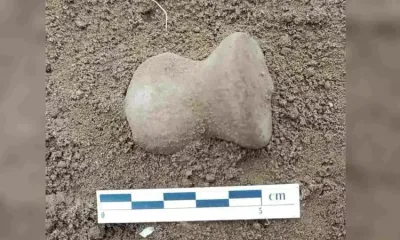 Krishnagiri- State Minister for Finance and Archeology, Thangam Thennarasu on Thursday informed that the archaeologists of the Tamil Nadu State Department Archaeology (TNSDA) have unearthed a flint seal in the ongoing excavation work at Sennanur site in Krishnagiri district. The flint seal measures 4.5 On June 24, a broken Neolithic tool was found in the excavation site in Sennanur.
Krishnagiri- State Minister for Finance and Archeology, Thangam Thennarasu on Thursday informed that the archaeologists of the Tamil Nadu State Department Archaeology (TNSDA) have unearthed a flint seal in the ongoing excavation work at Sennanur site in Krishnagiri district. The flint seal measures 4.5 On June 24, a broken Neolithic tool was found in the excavation site in Sennanur.
Class 7 girl falls from TNSTC bus while standing on footboard; dies (dtnext.in)
HONGRIE – x Mohács National Memorial Site - Over 150 skeletons and numerous artifacts are expected to be unearthed during the recently launched excavation of the mass grave No. IV of the Mohács National Memorial Site (southwestern Hungary), say experts. The preliminary anthropological findings of the remains of mass grave No. III, excavated between 2020-22, confirm that the victims of the execution after the Battle of Mohács (August 29, 1526) may have been buried in the grave. The expert anthropologist explained that the skeletons found in mass grave No. III were mainly those of young men, but there were also some older men, a few women and even one or two children. All this suggests that members of the Ottoman army may have taken prisoners outside the battlefield, in the Hungarian camps, and that they may have been victims of the mass execution of August 31, 1526, together with the captured soldiers.
Mass Grave Unearthed Near 16th Century Battlefield (hungarytoday.hu)
AUTRICHE – 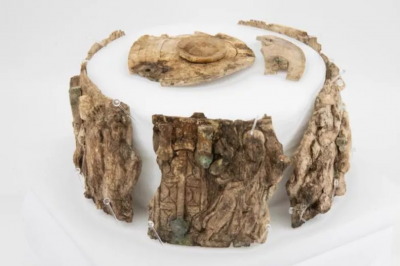 Irschen - Innsbruck archaeologists have been excavating in an old hilltop settlement in southern Austria since the summer of 2016. They made the incredible discovery of a Christian reliquary concealed in a previously unknown church two years ago. This reliquary contained an ancient ivory box, richly decorated with Christian symbols. The incredible artifact was discovered on August 4, 2022, in an early Christian church on the Burgbichl hill in Irschen, southern Austria, by a team headed by archaeologist Gerald Grabherr. A marble shrine measuring around 20 by 30 centimeters was hidden under the altar in the side chapel area. The artifact in question is heavily fragmented, but researchers said the pieces once formed a type of round container known as a “pyx” that in this case was made of ivory and richly decorated with Christian motifs. The shrine contained a heavily fragmented ivory “box” (pyx) richly decorated with Christian motifs – a reliquary that is normally taken away as the “holiest” part when a church is abandoned. In this case, however, it was left behind. It is the first such pyx to be found in an archaeological context in Austria.
Irschen - Innsbruck archaeologists have been excavating in an old hilltop settlement in southern Austria since the summer of 2016. They made the incredible discovery of a Christian reliquary concealed in a previously unknown church two years ago. This reliquary contained an ancient ivory box, richly decorated with Christian symbols. The incredible artifact was discovered on August 4, 2022, in an early Christian church on the Burgbichl hill in Irschen, southern Austria, by a team headed by archaeologist Gerald Grabherr. A marble shrine measuring around 20 by 30 centimeters was hidden under the altar in the side chapel area. The artifact in question is heavily fragmented, but researchers said the pieces once formed a type of round container known as a “pyx” that in this case was made of ivory and richly decorated with Christian motifs. The shrine contained a heavily fragmented ivory “box” (pyx) richly decorated with Christian motifs – a reliquary that is normally taken away as the “holiest” part when a church is abandoned. In this case, however, it was left behind. It is the first such pyx to be found in an archaeological context in Austria.
1,500-Year-Old Christian Ivory Reliquary Box Discovered in Austria - Arkeonews
COREE du SUD -  Jjoksaem - Archaeologists have made a groundbreaking discovery in the ancient capital of the Silla Kingdom (57 BC-AD 935) in the ancient tombs site at Jjoksaem in Gyeongju that challenges long-held assumptions about early Korean burial practices. Gyeongju, also known as Seorabeol, is a coastal city in the far southeastern corner of North Gyeongsang Province, South Korea. The ancient tombs site at Jjoksaem in Gyeongju serves as a collective burial ground for Silla royalty and nobility located to the east of the Daereungwon Ancient Tomb Complex, which houses the Cheonmachong Tomb and Hwangnamdaechong Tomb—tombs of Silla’s prominent rulers. The Silla kingdom ruled south-eastern Korea during the Three Kingdoms period from the 1st century BCE to the 7th century CE. The capital was Geumseong (Gyeongju) with a centralized government and hierarchical system of social ranks. In the ancient world, the Korean kingdom of Silla was renowned as a country of gold. Two recently excavated tombs in Gyeongju’s Jjoksaem district have revealed a previously unknown burial type for the period, according to a statement made on Wednesday by the Gyeongju National Research Institute of Cultural Heritage. Typical early Silla burials feature a wooden frame (dutneol) for the body, covered by an earthen mound and surrounded by a distinctive stone boundary. The newly discovered tombs, provisionally named J171 and J172, lack this characteristic stone perimeter.In addition, archaeologists also uncovered a trove of artifacts within the mounds, including decorated pottery lids, legged bowls, and an array of silver-laden equipment for horses – a rarity in previous excavations. The rare silver horse ornaments have sparked particular interest, as they are considered to have been important status symbols in ancient Silla society.
Jjoksaem - Archaeologists have made a groundbreaking discovery in the ancient capital of the Silla Kingdom (57 BC-AD 935) in the ancient tombs site at Jjoksaem in Gyeongju that challenges long-held assumptions about early Korean burial practices. Gyeongju, also known as Seorabeol, is a coastal city in the far southeastern corner of North Gyeongsang Province, South Korea. The ancient tombs site at Jjoksaem in Gyeongju serves as a collective burial ground for Silla royalty and nobility located to the east of the Daereungwon Ancient Tomb Complex, which houses the Cheonmachong Tomb and Hwangnamdaechong Tomb—tombs of Silla’s prominent rulers. The Silla kingdom ruled south-eastern Korea during the Three Kingdoms period from the 1st century BCE to the 7th century CE. The capital was Geumseong (Gyeongju) with a centralized government and hierarchical system of social ranks. In the ancient world, the Korean kingdom of Silla was renowned as a country of gold. Two recently excavated tombs in Gyeongju’s Jjoksaem district have revealed a previously unknown burial type for the period, according to a statement made on Wednesday by the Gyeongju National Research Institute of Cultural Heritage. Typical early Silla burials feature a wooden frame (dutneol) for the body, covered by an earthen mound and surrounded by a distinctive stone boundary. The newly discovered tombs, provisionally named J171 and J172, lack this characteristic stone perimeter.In addition, archaeologists also uncovered a trove of artifacts within the mounds, including decorated pottery lids, legged bowls, and an array of silver-laden equipment for horses – a rarity in previous excavations. The rare silver horse ornaments have sparked particular interest, as they are considered to have been important status symbols in ancient Silla society.
The new type of Silla tombs discovered in Gyeongju, South Korea - Arkeonews
ESPAGNE -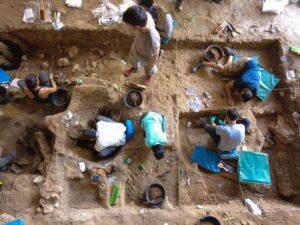
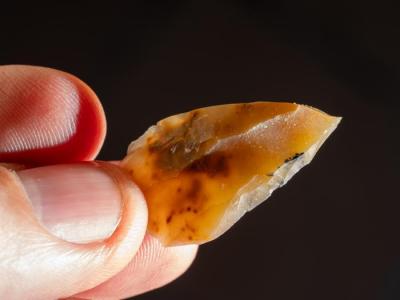 Abrigo de la Malia - A new analysis* of artifacts and fossils from a prehistoric rock shelter in central Iberia challenges the idea that the region housed no humans from 42,000 to 19,000 years ago. Instead, the shelter holds traces of ongoing occupation in the Upper Paleolithic, including tools associated with Early European modern humans called Aurignacians. Hominins are known to have occupied the Iberian Peninsula for most of the Paleolithic, save for a period between Neanderthals’ extinction roughly 42,000 years ago and the Last Glacial Maximum’s thaw 19,000 years ago. It was thought that mountainous central Iberia’s cold and harsh climate during this time rendered it an uninhabitable “nobody’s land” and established a geographic boundary between early human populations. Recently though, research has indicated that some humans actually lived in this area as early as 26,000 years ago. Yet, a period of 16,000 years remains where the region’s history of habitation is unknown. Now, Nohemi Sala and colleagues fill in this temporal gap with the discovery of an Upper Paleolithic rock shelter called the Abrigo de la Malia found in 2017 in Guadalajara, Spain. They employed techniques, including radiocarbon dating, to examine sediment, fossilized teeth and bone, and charcoal fragments at Malia. This work indicated the shelter had continuous human activity 36,200 – 31,760 years ago and frequent re-settlement up to 26,260 years ago. Other artifacts from the site, such as shaped flint and bone blades, resemble those found at Aurignacian sites. This Upper Paleolithic culture prevailed in Europe from around 43,000 to 28,000 years ago. The shelter occupants’ ties to the Aurignacians imply that harsh conditions in central Iberia at the time did not prevent cultural exchange.
Abrigo de la Malia - A new analysis* of artifacts and fossils from a prehistoric rock shelter in central Iberia challenges the idea that the region housed no humans from 42,000 to 19,000 years ago. Instead, the shelter holds traces of ongoing occupation in the Upper Paleolithic, including tools associated with Early European modern humans called Aurignacians. Hominins are known to have occupied the Iberian Peninsula for most of the Paleolithic, save for a period between Neanderthals’ extinction roughly 42,000 years ago and the Last Glacial Maximum’s thaw 19,000 years ago. It was thought that mountainous central Iberia’s cold and harsh climate during this time rendered it an uninhabitable “nobody’s land” and established a geographic boundary between early human populations. Recently though, research has indicated that some humans actually lived in this area as early as 26,000 years ago. Yet, a period of 16,000 years remains where the region’s history of habitation is unknown. Now, Nohemi Sala and colleagues fill in this temporal gap with the discovery of an Upper Paleolithic rock shelter called the Abrigo de la Malia found in 2017 in Guadalajara, Spain. They employed techniques, including radiocarbon dating, to examine sediment, fossilized teeth and bone, and charcoal fragments at Malia. This work indicated the shelter had continuous human activity 36,200 – 31,760 years ago and frequent re-settlement up to 26,260 years ago. Other artifacts from the site, such as shaped flint and bone blades, resemble those found at Aurignacian sites. This Upper Paleolithic culture prevailed in Europe from around 43,000 to 28,000 years ago. The shelter occupants’ ties to the Aurignacians imply that harsh conditions in central Iberia at the time did not prevent cultural exchange.
Archaeological site proves central Iberia had human inhabitants during the Upper Paleolithic – Popular Archeology (popular-archaeology.com)
CHYPRE –  Kyrenia - Updated radiocarbon calibration techniques provide improved date estimates for Greek shipwrecks, according to a study published June 26 in the open-access journal PLOS ONE by Sturt Manning of Cornell University, US, and colleagues. The Kyrenia Ship was found in the 1960s off the coast of Cyprus, and it has become a key vessel in the study of ancient Greek shipbuilding. Archaeological evidence has indicated the age of the ship’s final voyage at around 300 BCE, but previous radiocarbon dating efforts have not lined up with the archaeological evidence. Manning and colleagues suggest that this discrepancy is due to outdated radiocarbon calibration daAccurate radiocarbon dating relies on calibration data based on known-age tree-ring dates to correct for error caused by variation in atmospheric carbon over time. As radiocarbon dating techniques have improved, some time periods within the current Northern Hemisphere calibration curve have yet to be updated. In this study, the researchers applied new tree-ring samples and modern dating techniques to revise calibration data for the period between 433-250 BCE. The authors then applied the updated calibration to newly acquired radiocarbon dates on materials from the Kyrenia Ship (both from the ship and its final cargo). The resulting dates are compatible with existing archaeological data, and they indicate the ship’s last voyage around 280 BCE, slightly later than previous estimates. The authors also applied the new radiocarbon calibration curve to radiocarbon dates from another Greek ship, the Mazotos ship, and estimated an age around 370 BCE for the last voyage, again slightly later than indicated by previous research.This study emphasizes the importance of continuing revision of radiocarbon calibration data. The authors note that further refinements to this and other time periods will be especially important for archaeological materials which require dating precision on the order of decades. The authors add: “We are excited to apply scientific techniques to date the famous Kyrenia Ship a little over 2300 years ago. Central to the history of ship technology and maritime trade in the classical Mediterranean, the methods we use to date the ship – and solutions to various technical challenges we had to overcome – will now help date other shipwrecks and better inform the history of ancient seafaring.”
Kyrenia - Updated radiocarbon calibration techniques provide improved date estimates for Greek shipwrecks, according to a study published June 26 in the open-access journal PLOS ONE by Sturt Manning of Cornell University, US, and colleagues. The Kyrenia Ship was found in the 1960s off the coast of Cyprus, and it has become a key vessel in the study of ancient Greek shipbuilding. Archaeological evidence has indicated the age of the ship’s final voyage at around 300 BCE, but previous radiocarbon dating efforts have not lined up with the archaeological evidence. Manning and colleagues suggest that this discrepancy is due to outdated radiocarbon calibration daAccurate radiocarbon dating relies on calibration data based on known-age tree-ring dates to correct for error caused by variation in atmospheric carbon over time. As radiocarbon dating techniques have improved, some time periods within the current Northern Hemisphere calibration curve have yet to be updated. In this study, the researchers applied new tree-ring samples and modern dating techniques to revise calibration data for the period between 433-250 BCE. The authors then applied the updated calibration to newly acquired radiocarbon dates on materials from the Kyrenia Ship (both from the ship and its final cargo). The resulting dates are compatible with existing archaeological data, and they indicate the ship’s last voyage around 280 BCE, slightly later than previous estimates. The authors also applied the new radiocarbon calibration curve to radiocarbon dates from another Greek ship, the Mazotos ship, and estimated an age around 370 BCE for the last voyage, again slightly later than indicated by previous research.This study emphasizes the importance of continuing revision of radiocarbon calibration data. The authors note that further refinements to this and other time periods will be especially important for archaeological materials which require dating precision on the order of decades. The authors add: “We are excited to apply scientific techniques to date the famous Kyrenia Ship a little over 2300 years ago. Central to the history of ship technology and maritime trade in the classical Mediterranean, the methods we use to date the ship – and solutions to various technical challenges we had to overcome – will now help date other shipwrecks and better inform the history of ancient seafaring.”
Updated radiocarbon dates for the Greek shipw | EurekAlert!